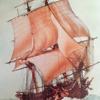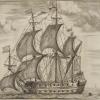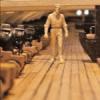-
Posts
1,763 -
Joined
-
Last visited
Reputation Activity
-
 Mark P got a reaction from hexnut in HMS Dragon 1760 by Siggi52 - FINISHED - Scale 1:48 - English 74-Gun ship
Mark P got a reaction from hexnut in HMS Dragon 1760 by Siggi52 - FINISHED - Scale 1:48 - English 74-Gun ship
Hi Siggi;
Thanks for posting that excerpt about the washing etc. Very interesting.
There were some very cruel captains. Piggott, of the 'Hermione,' who was so bad that his crew murdered him, was an extreme example.
On the other hand, even the Admiralty could be amenable at times. When the crews of the ships at Spithead mutinied, without violence, in 1797 (although they made it clear that if the enemy came around they would return to duty) their quite reasonable demands were agreed to. It was only later, when crews in other bases tried to extract more concessions that things turned nasty (although this seems in great part due to the character of the ringleaders)
As with so many things, I think it all comes down to the fact that there are many different types of people, and each behaves differently.
All the best,
Mark P
-
 Mark P got a reaction from Elijah in HMS Atalanta 1775 by tlevine - FINISHED - 1:48 scale - from TFFM plans
Mark P got a reaction from Elijah in HMS Atalanta 1775 by tlevine - FINISHED - 1:48 scale - from TFFM plans
Nice work and a great model, Toni. I like the idea of the lids on the stove being in brass; think I'll do this myself, even if they will hardly be visible.
All the best,
Mark P
-
 Mark P got a reaction from WackoWolf in HMS Dragon 1760 by Siggi52 - FINISHED - Scale 1:48 - English 74-Gun ship
Mark P got a reaction from WackoWolf in HMS Dragon 1760 by Siggi52 - FINISHED - Scale 1:48 - English 74-Gun ship
Hi Siggi;
Thanks for posting that excerpt about the washing etc. Very interesting.
There were some very cruel captains. Piggott, of the 'Hermione,' who was so bad that his crew murdered him, was an extreme example.
On the other hand, even the Admiralty could be amenable at times. When the crews of the ships at Spithead mutinied, without violence, in 1797 (although they made it clear that if the enemy came around they would return to duty) their quite reasonable demands were agreed to. It was only later, when crews in other bases tried to extract more concessions that things turned nasty (although this seems in great part due to the character of the ringleaders)
As with so many things, I think it all comes down to the fact that there are many different types of people, and each behaves differently.
All the best,
Mark P
-
 Mark P got a reaction from robin b in HMS Dragon 1760 by Siggi52 - FINISHED - Scale 1:48 - English 74-Gun ship
Mark P got a reaction from robin b in HMS Dragon 1760 by Siggi52 - FINISHED - Scale 1:48 - English 74-Gun ship
Hi Siggi;
Thanks for posting that excerpt about the washing etc. Very interesting.
There were some very cruel captains. Piggott, of the 'Hermione,' who was so bad that his crew murdered him, was an extreme example.
On the other hand, even the Admiralty could be amenable at times. When the crews of the ships at Spithead mutinied, without violence, in 1797 (although they made it clear that if the enemy came around they would return to duty) their quite reasonable demands were agreed to. It was only later, when crews in other bases tried to extract more concessions that things turned nasty (although this seems in great part due to the character of the ringleaders)
As with so many things, I think it all comes down to the fact that there are many different types of people, and each behaves differently.
All the best,
Mark P
-
 Mark P got a reaction from mtaylor in HMS Dragon 1760 by Siggi52 - FINISHED - Scale 1:48 - English 74-Gun ship
Mark P got a reaction from mtaylor in HMS Dragon 1760 by Siggi52 - FINISHED - Scale 1:48 - English 74-Gun ship
Hi Siggi;
Thanks for posting that excerpt about the washing etc. Very interesting.
There were some very cruel captains. Piggott, of the 'Hermione,' who was so bad that his crew murdered him, was an extreme example.
On the other hand, even the Admiralty could be amenable at times. When the crews of the ships at Spithead mutinied, without violence, in 1797 (although they made it clear that if the enemy came around they would return to duty) their quite reasonable demands were agreed to. It was only later, when crews in other bases tried to extract more concessions that things turned nasty (although this seems in great part due to the character of the ringleaders)
As with so many things, I think it all comes down to the fact that there are many different types of people, and each behaves differently.
All the best,
Mark P
-
 Mark P got a reaction from CaptainSteve in HMS Dragon 1760 by Siggi52 - FINISHED - Scale 1:48 - English 74-Gun ship
Mark P got a reaction from CaptainSteve in HMS Dragon 1760 by Siggi52 - FINISHED - Scale 1:48 - English 74-Gun ship
Hi Siggi;
Thanks for posting that excerpt about the washing etc. Very interesting.
There were some very cruel captains. Piggott, of the 'Hermione,' who was so bad that his crew murdered him, was an extreme example.
On the other hand, even the Admiralty could be amenable at times. When the crews of the ships at Spithead mutinied, without violence, in 1797 (although they made it clear that if the enemy came around they would return to duty) their quite reasonable demands were agreed to. It was only later, when crews in other bases tried to extract more concessions that things turned nasty (although this seems in great part due to the character of the ringleaders)
As with so many things, I think it all comes down to the fact that there are many different types of people, and each behaves differently.
All the best,
Mark P
-
 Mark P got a reaction from AON in HMS Dragon 1760 by Siggi52 - FINISHED - Scale 1:48 - English 74-Gun ship
Mark P got a reaction from AON in HMS Dragon 1760 by Siggi52 - FINISHED - Scale 1:48 - English 74-Gun ship
Hi Siggi;
Thanks for posting that excerpt about the washing etc. Very interesting.
There were some very cruel captains. Piggott, of the 'Hermione,' who was so bad that his crew murdered him, was an extreme example.
On the other hand, even the Admiralty could be amenable at times. When the crews of the ships at Spithead mutinied, without violence, in 1797 (although they made it clear that if the enemy came around they would return to duty) their quite reasonable demands were agreed to. It was only later, when crews in other bases tried to extract more concessions that things turned nasty (although this seems in great part due to the character of the ringleaders)
As with so many things, I think it all comes down to the fact that there are many different types of people, and each behaves differently.
All the best,
Mark P
-
 Mark P got a reaction from EricWilliamMarshall in Greenwich Hospital barge of 1832 by druxey - FINISHED - 1:48 scale
Mark P got a reaction from EricWilliamMarshall in Greenwich Hospital barge of 1832 by druxey - FINISHED - 1:48 scale
Greetings Druxey;
I have some photos of the stern, with mermaids holding dolphins, and other carving details, but unfortunately none of the rowing benches. I do remember that they had the typical central plank joining all the thwarts, and parallel to the keel. However, I will be back at the NMM before too long, and I will take some more pictures for you.
In the meantime, I am posting those I have already taken. For anyone else interested in the details of the carving, I will also post these on the contemporary models gallery.
All the best,
Mark P
The first two (they were last when I uploaded them!) are of the interior of the cabin, and taken through the glass. It takes a few moments to realise what is inside the glass, and what is a reflection.
-
 Mark P got a reaction from albert in HMS Naiad 1797 by albert - FINISHED - 1/48
Mark P got a reaction from albert in HMS Naiad 1797 by albert - FINISHED - 1/48
Greetings Albert;
I have just found your log, which I will now follow with great interest. Your work is of a very high standard, beautiful to look at, and shows again what can be achieved by those who take care and pride in their models.
I am in agreement with so many others' posts on another thing: I too am envious of your so tidy workshop!
Every time I look at such great craftsmanship I just can't wait to get started on my own project (still finishing off the workshop, seems to be taking forever!)
All the best,
Mark P
-
 Mark P got a reaction from paulsutcliffe in HMS Naiad 1797 by albert - FINISHED - 1/48
Mark P got a reaction from paulsutcliffe in HMS Naiad 1797 by albert - FINISHED - 1/48
Greetings Albert;
I have just found your log, which I will now follow with great interest. Your work is of a very high standard, beautiful to look at, and shows again what can be achieved by those who take care and pride in their models.
I am in agreement with so many others' posts on another thing: I too am envious of your so tidy workshop!
Every time I look at such great craftsmanship I just can't wait to get started on my own project (still finishing off the workshop, seems to be taking forever!)
All the best,
Mark P
-
 Mark P got a reaction from Bluto 1790 in HMS Naiad 1797 by albert - FINISHED - 1/48
Mark P got a reaction from Bluto 1790 in HMS Naiad 1797 by albert - FINISHED - 1/48
Greetings Albert;
I have just found your log, which I will now follow with great interest. Your work is of a very high standard, beautiful to look at, and shows again what can be achieved by those who take care and pride in their models.
I am in agreement with so many others' posts on another thing: I too am envious of your so tidy workshop!
Every time I look at such great craftsmanship I just can't wait to get started on my own project (still finishing off the workshop, seems to be taking forever!)
All the best,
Mark P
-
 Mark P got a reaction from mtaylor in HMS Naiad 1797 by albert - FINISHED - 1/48
Mark P got a reaction from mtaylor in HMS Naiad 1797 by albert - FINISHED - 1/48
Greetings Albert;
I have just found your log, which I will now follow with great interest. Your work is of a very high standard, beautiful to look at, and shows again what can be achieved by those who take care and pride in their models.
I am in agreement with so many others' posts on another thing: I too am envious of your so tidy workshop!
Every time I look at such great craftsmanship I just can't wait to get started on my own project (still finishing off the workshop, seems to be taking forever!)
All the best,
Mark P
-
 Mark P got a reaction from Canute in HMS Naiad 1797 by albert - FINISHED - 1/48
Mark P got a reaction from Canute in HMS Naiad 1797 by albert - FINISHED - 1/48
Greetings Albert;
I have just found your log, which I will now follow with great interest. Your work is of a very high standard, beautiful to look at, and shows again what can be achieved by those who take care and pride in their models.
I am in agreement with so many others' posts on another thing: I too am envious of your so tidy workshop!
Every time I look at such great craftsmanship I just can't wait to get started on my own project (still finishing off the workshop, seems to be taking forever!)
All the best,
Mark P
-
 Mark P got a reaction from Canute in Micro-Edge Sander
Mark P got a reaction from Canute in Micro-Edge Sander
Thank wefalck for posting this. An ingenious little device, with its construction clearly described.
All the best,
Mark p
-
 Mark P reacted to lehmann in Seeking information on determining load waterline
Mark P reacted to lehmann in Seeking information on determining load waterline
The estimation of load water line and tonnage (displacement or cargo capacity) is just that - an estimation to as a check on the designer's intention that the vessel could fulfill its role. Nowadays, we understand the physics, the mathematics have been simplified (even without the aid of computers to do the repetitive number crunching), and we have accurate measurements to prove everything. At the time there were many unknowns and uncertainties, but the the designer still needs some assurance he can be proud of the design, or at the least, not be sued. These various formulas are nothing more than first approximations that included some basic factors that were easy to measure mixed with a few fudge factors that make the numbers fit with "experience" or a consensus of opinion. The ease of measurement is important in that different people would get the same results and those who didn't have access to more sophisticated measurement tools were not left at a disadvantage.
As an engineer, I still do a "back of the envelope" calculation like this as a reality check of a computer model analysis. You may not realize that some rules in standards, such as the National Building Code, are still based on a consensus of experts when the theoretical and experimental data does not provide sufficient information.
The fudge factors would, I assume, vary depending on region, or predominant ship design. Factors that "work" for shallow draft coastal boats don't work for deep water clipper ships. However, customs and insurance officials like to have a common formula that can be easily and uniformly applied by their inspectors. The question arises, who chooses which rule to use? Ship owners pick the lowest when charged for customs and insurance, and the highest when impressing a customer. The same is done now in all aspects of business, even if standards organizations are tasked with choosing an evaluation method: there are always factions trying to influence the choice. It also reminds me of the rating formulas for racing yachts, which resulted in some strange looking boats. I recall reading somewhere that tonnage rules also produced some un-seaworthy distortions as owners found hull shapes that maximized actual cargo capacity relative to the rated tonnage. As with all business performance measures, there will always be someone who "games" the formula, resulting in an unintended consequence.
My conclusion is that tonnage rules are a different animal than displacement calculations for load waterline or trim. The tonnage rules have a strong connection to politics and influence. On the performance side, it may be possible with computational fluid dynamics programs to choose the best displacement and trim for best sailing qualities, but I doubt anyone has figured out the hull design that is the best compromise for all sea conditions, cargoes and sail trim: maybe the designers of the America's Cup boats get the closest to this ideal. Even with computer models, there are still several model ship testing basins used for experimental validation. There is still a lot of evolution in ship design and that the key to evolution is survival - physical and economic. The main difference between 2016 and 1816 is that designers have the tools to avoid the failures. I'm not sure a modern designer, forced to work with wood and hemp, could design a better ship than their predecessors developed by trial and (lots of) error.
-
 Mark P reacted to mtaylor in Seeking information on determining load waterline
Mark P reacted to mtaylor in Seeking information on determining load waterline
Bruce,
I think I agree. It's sort of like in certain states in the US that for taxation purposes there's a formula for HP of an automobile. It has zip to do with real world measurements and (in this case, autos) it's seldom the same from State to State.
-
 Mark P reacted to trippwj in Seeking information on determining load waterline
Mark P reacted to trippwj in Seeking information on determining load waterline
By all means, feel free to print it off and peruse at your leisure!
I keep going back to that Humphreys calculation and pondering why the tunnage is so great. Here is a direct paste from his 1793 letter to Samuel Hodgdon:
Dec 16, 1793
Dear Sir
I think it necessary to inform you in what manner the tonnage is calculated that I have made the estimate from.
In the first place to find the length of straight rabbet forward you take 3/5 of the beam as usual from that point to the after part of the stern post allowing its width for measurement not to exceed 1/12 of the beam. That length being determined you then multiply it by the length of beam & that product by the height of the gundeck beam amidship on the top of the beam added to half of her waste amids which last product divide by 95 which will give the number of ton required.
I am respectfully yours &c
Joshua Humphreys
It is that additional factor (1/2 her waste amidship) that results in the dramatic increase in tunnage.
I pulled up another description from him dated 1804 (in response to an inquiry from the auditor of the navy concerning builders measure in Philadelphia in 1799). In this letter, he does NOT include that addition to the depth of hold!
'Dear Sir
I shall with pleasure endeavour to explain the Mode of ascertaining the Tonnage you require I hope it will be satisfactory.
The rule for ascertaining of Tonage of Vessels Carpenters Measure in this Port in the Years 1799 & 18oo was as follows-
Breadth of Beam was ascertained from the outside to outside of the timbers - or the Moulded Breadth at dead flat or widest part of the Ship or from
inside to inside of the plank or Wales at the same place, which is the same thing. When the length of Beam is so found you take three fifths of its length which is allowed for the rake of the Stem, let the rake be what it may either more or less - but the rake is generally less- In order to assertain the point of straight rabbet on the Keel, you must set 12 inches before the rabbet of the Stem at the height of the Gundeck from that point let fall a line at right Angles with the rabbet of the Keel then Measure from that line 3/5 of the Beam & wherever that distance terminates on the Keel is the point called straight rabbet & from which to the rabbet of the stern post is the length of Keel for Tonage Carpenters measure of this Port - then Multiply the length of the Keel so found
by the Breadth of the Beam as above & that product by half the length of the Beam- which last product divide by ninety five which will give the Number
of Tons required. (transcription provided in M. V. Brewington. 1941. Notes: Tonnage Rules in 1799. The American Neptune: A Quarterly Journal of Maritime History and Arts I, no. 3: 295–296. http://phillipslibrarycollections.pem.org/cdm/compoundobject/collection/p15928coll3/id/939).
When I change the depth of hold to 1/2 the beam, the calculated tunnage is much more agreeable - 1080 & 68/95 tuns carpenters measure.
Mr. Humphreys was an interesting character, and regrettably his working notebook (compilation of all sorts of tidbits around shipbuilding &c.), while containing a great deal of information, is NOT chronological, in the sense that it traces events in order, but rather a sequential listing of information in the order it was entered. For example, the first entry is a transcription of the British 1719 Establishment, followed by a description of some method of ascertaining tunnage (NOT either of the two above given), then followed by more of the 1719 Establishment. This is then followed by an entry titled "Navy Office, August 1st 1737 Dimensions", and about 20 pages later "An abstract of numbers, natures, lengths & weight of cannon according to several rates of ships as proposed at a meeting of Flag Office and established by His Majestic Council on the 6th of July, 1716."
-
 Mark P got a reaction from trippwj in Seeking information on determining load waterline
Mark P got a reaction from trippwj in Seeking information on determining load waterline
Dear Wayne;
You have put a serious amount of time and effort into researching all this, with many interesting contributions from others added in, and it is fascinating stuff. I had no idea that Matthew Baker was calculating such things as described in this thread.
As has been said earlier in this thread, it would appear that Deane's role in all this has been somewhat aggrandised by Pepys.
And with regard to your last post, it would be a rather unfortunate merchant who had his customs dues calculated by Mr Humphrey's method. He appears to be considerably off the mark.
Would you mind if I printed off this thread to read in more leisurely circumstances?
All the best,
Mark P
-
 Mark P got a reaction from dafi in Seeking information on determining load waterline
Mark P got a reaction from dafi in Seeking information on determining load waterline
Dear Wayne;
You have put a serious amount of time and effort into researching all this, with many interesting contributions from others added in, and it is fascinating stuff. I had no idea that Matthew Baker was calculating such things as described in this thread.
As has been said earlier in this thread, it would appear that Deane's role in all this has been somewhat aggrandised by Pepys.
And with regard to your last post, it would be a rather unfortunate merchant who had his customs dues calculated by Mr Humphrey's method. He appears to be considerably off the mark.
Would you mind if I printed off this thread to read in more leisurely circumstances?
All the best,
Mark P
-
 Mark P reacted to trippwj in Seeking information on determining load waterline
Mark P reacted to trippwj in Seeking information on determining load waterline
There are several dozen potential ways that have been identified by Salisbury (among others) for measuring tunnage. For the sake of simplicity and illustration, I am only going to highlight a few of them.
Mr. Bakers Old Rule (from about 1582):
The old way, which was established in Queen Elizabeth's time, and never questioned all King James time, is this: The length of the keel, leaving out the false post, if there be any. Multiply by the greatest breatdh within the plank, and that product by the depth taken from the breadth to the upper edge of the keel produceth a solid number which divided by 100 gives the contents in tons, into which add one third part for tonnage, so have you the tons and tonnage.
K = Length of keel excluding false post
B = greatest breadth within plank
D = depth from B to upper edge of keel
Divisor = 100
Naval Papers of Peter Pett (about 1650)
Take the Length from the inside on the Upper Deck between the Stem and the Sternpost, and the greatest Breadth from Outside to Outside: likewise, the Depth from the underpart of the Beam of the Upper Deck to the floor by the side of the Keelson. Multiply the Length by the Breadth, and that by the half Breadth, except the Depth exceed the half Breadth, then you are to multiply by that and divide the quotient by 110.
K = Inside on upper deck between stem and stern post
B = greatest breadth outside to outside
D = depth from underpart of beam to floor by side of the keelson or ½ B, whichever is greater
Divisor = 110
The Massachusetts Rates and Duties Act. (In The Acts and Resolves of the Massachusetts Bay (Boston, 1869-1922), I, pp. 207-8.) (from about 1695)
... the breadth at the main beam within board, the depth to be accounted half the said breadth, and the length three times so much as the breadth, after the usual manner of multiplying, and dividing the product by one hundred.
K = 3 x B
B = width at main beam within board
D = ½ B
Divisor = 100
An Act for Making a Convenient Dock or Basin at Liverpool (1709)
Take the length of the keel of every ship or vessel so much as she treads on the ground and the breadth to be taken within board by the midship beam from plank to plank and half that breadth shall be accounted for the depth ... Then the tonnage will be (L x B x D)/94… any custom practice or usage notwithstanding.
K = Length of keel treads on ground
B = width at midship beam within board
D = ½ B
Divisor = 94
13 Geo. III, c. 74 (pg 1) (The Smuggling Act.) The' Old Rule', adopted for general use in all later Acts until the 'New Measurement' of 1836. (1772)
The length shall be taken on a straight line along the rabbit of the keel of the ship, from the back of the main-post to a perpendicular line from the fore part of the main-stem under the bowsprit; from which subtracting three fifths of the breadth, the remainder must be esteemed the just length of the keel to find the tonnage; and the breadth shall be taken from the outside of the outside plank, in the broadest place in the ship, be it either above or below the main wales, exclusive of all manner of doubling-planks that may be wrought upon the sides of the ship; then, multiplying the length of the keel by the breadth so taken, and that product by half the breadth, and dividing the whole by ninety four, the quotient will be deemed the true contents of the tonnage. According to which rule the tonnage of all such ships and vessels shall be measured and ascertained, anything in the said recited act of the sixth of George I, or any other act or acts of parliament, to the contrary notwithstanding.
K = Along rabbet of keel from back of main post to perpendicular from forepart of main stem below bowsprit, minus 3/5 B
B = greatest breadth outside to outside exclusive of doublings
D = ½ B
Divisor = 94
U.S. Stat. L, vol. I, p. 55. United States Tonnage Law, passed 1st September 1789. Known as 'Custom House Measurement'. (1789)
The length was measured from the fore part of the main stem, to the after part of the sternpost, above the upper deck. From this, 3/5 of the beam was deducted in order to obtain the Length for Tonnage. The breadth was measured at the broadest part above the main wales. The depth varied. In single decked vessels the depth was measured from the underside of the deck plank to the ceiling in the hold. In ships with two or more decks, the depth was taken to be half the breadth.
K = the fore part of the main stem, to the after part of the sternpost, above the upper deck minus 3/5 B
B = the broadest part above the main wales
D = Single decked: underside of deck plank to ceiling in hold. Double decked = ½ B
Divisor = 95
Joshua Humphreys, War Department Papers TNB06 (1793) http://wardepartmentpapers.org/document.php?id=9527
In the first place to find the length of straight rabbet forward you take 3/5 of the beam as usual from that point to the after part of the stern post allowing its width for measurement not to exceed 1/12 of the beam. That length being determined you then multiply it by the length of beam & that product by the height of the gundeck beam amidship on the top of the beam added to half of her waste amids which last product divide by 95 which will give the number of ton required.
K = length of straight rabbet forward minus 3/5 B to after side stern post
B = width at midship beam within board
D = top of gun deck beam to floor plus ½ B
Divisor = 95
The following are provided in Steel’s Vade Mecum (1805)
THE GENERAL RULES OBSERVED FOR MEASURING THE TONNAGE OF SHIPS IN THE KING'S AND MERCHANTS’ SERVICE, ARE AS FOLLOW.
Let fall a perpendicular from the foreside of the stem, at the height of the hawse-holes*, and another perpendicular from the back of the main post, at the height of the wing transom.
From the length between these perpendiculars, deduct three-fifths of the extreme breadth+, and likewise as many 21/2 inches as the wing transom is high from the upper edge of the keel, and the remainder is accounted the length of the keel for tonnage.
Then multiply the length of the keel for tonnage by the extreme breadth, and that product by half the extreme breadth; then, dividing by 94, the quotient will be the burthen in what is denominated Builder's Tonnage.
Or, Multiply the length of the keel for tonnage by the square of the extreme breadth, and divide the product by 188, the quotient will be the burthen in tons.
K = length from foreside stem at hawse holes to back of main post at wing transom minus 3/5 B minus 2 ½ “ per height of wing transom above upper edge of keel.
B = extreme breadth outside to outside
D = ½ B
Divisor = 94
* In the merchant-service, this perpendicular is let fall from the foreside of the stem, at the height of the wing transom, by reason of the hawse-holes being generally so very high, and their stems also having a great rake forward.
+ By the extreme breadth, is meant the breadth taken from timber to timber outside, with the thickness of the bottom on each side added; or, which is the same thing, the thickness of the bottom on each side added to the moulded breadth.
RULES BY MR. PARKYNS, LATE OF HIS MAJESTY's YARD, CHATHAM.
RULE I. For Sharp Ships, particularly those of the Royal Navy,
Take the length on the gun-deck, from the rabbet of the stem to the rabbet of the stern-post, or between the perpendiculars. Then take 23/24 of this length, and call if the keel for tonnage:
To the extreme breadth add the length of the gun-deck, or length between the perpendiculars; then take 1/23 of this sum, and call it the depth for tonnage,
Set up this depth from the limber strake; and, at that height, take a breadth also from out to outside of the plank at dead-flat, and another breadth between that and the limber strake; add together the extreme breadth and these two breadths; take one-third of the sum, and call it the breadth for tonnage.
Multiply the length for tonnage by the depth for tonnage, and the product by the breadth for tonnage, and divide by 49. The quotient will be the burthen in tons nearly.
K = Length on gun deck (between perpendiculars) x 23/24
B = at height D above limber strake take breadth outside to outside. Add to extreme breadth plus breadth at limber strake divide the sum by 3.
D = extreme breadth plus LBP x 1/23
Divisor = 49
Rule II. For Ships of Burthen, or Commercial Ships, in general,
Take the length of the lower deck, from the rabbet of the stem to the rabbet of the stem-post; then take 31/32 of this length, and call it the keel for tonnage.
To the extreme breadth add the length of the lower deck; then take 3/55 of the sum, and call it the depth for tonnage.
Set up this depth from the limber strake; and, at that height, take a breadth also from out to outside of the plank at dead-flat. Take another at two-thirds of this height, and another at one-third of the height. Add the extreme breadth and these three breadths together, and take one fourth of the sum for the breadth for tonnage.
Multiply the length for tonnage by the depth for tonnage and the product by the breadth for tonnage, and divide by 36.6666 or 36 2/3 and the quotient will be the burthen in tons.
K = Length on lower deck (between perpendiculars or LBP) x 31/32
B = at height D above limber strake take breadth outside to outside at dead flat. Take second at 2/3 this height and a third at ½ the height. Add to extreme breadth plus these three breadths and divide the sum by 4.
D = extreme breadth plus LBP x 3/55
Divisor = 36 2/3 (36.6666)
-
 Mark P reacted to trippwj in Seeking information on determining load waterline
Mark P reacted to trippwj in Seeking information on determining load waterline
Indeed! As "anonymous" pointed out (transcription courtesy of R. Barker) -
61. The height of the ship above water must be in proportion unto that part of the ship under water &c the height of the ship in the mid-ship must not exceed the depth under water & the height of the stern must not exceed the height of the depth twice & the height of the forecastle must not exceed the depth once & 1/3.
Not particularly scientific - more a rule of thumb based on existing practice and experience?
-
 Mark P reacted to lehmann in Seeking information on determining load waterline
Mark P reacted to lehmann in Seeking information on determining load waterline
If I may summarize Bourne's method: take the lines of the hull and build a scale model, in this case, 1/48 scale, measure the volume of water displaced by the model then multiply by 48 cubed and the density of water.
Do you have any indication this method was used? I suppose it is one use of half hull models.
I recall reading that this method is somewhat error prone, with the main problem being that the wooden model absorbs water.
It reminds me of another way to measure measure area: trace the shape onto paper on cardboard and weigh it. Also weigh a piece with a known area. Area of the irregular shape calculated by simple ratio.
-
 Mark P reacted to trippwj in Seeking information on determining load waterline
Mark P reacted to trippwj in Seeking information on determining load waterline
Still working on how best to visualize the parallel yet disjointed development of the science and implementation into shipbuilding. Not sure this really tells the story - I am thinking that it may be better graphically to keep the science on one side of the timeline and the application on the other. Your thoughts?
-
 Mark P reacted to trippwj in Seeking information on determining load waterline
Mark P reacted to trippwj in Seeking information on determining load waterline
Meaning no insult to Sir Anthony Deane, I wanted to take a moment to elaborate somewhat on earlier methods of determining the burthen of a ship.
William Bourne published a rather difficult to read (due to the typeface, see earlier post in this thread) treatise called A Booke Called the Treasure for Traveilers : Devided into Five Bookes or Partes, Contaynyng Very Necessary Matters, for All Sortes of Travailers, Eyther by Sea or by Lande.
Richard Barker has provided a transcription (and modernized the language) of the sections related to measuring ships. His transcription may be found here: http://home.clara.net/rabarker/Bourne2m.htm
Bourne describes two methods - in the first, the vessel is grounded, and the physical dimensions taken. His alternative method is described as "an easier way than rehearsed above, by the Art Statical, to know the true weight of any ship, with all her lading, and all the rest of her furniture". Here is a very brief excerpt - I encourage you to read the full description.
And now I caused the mould to be made for every foot, but a quarter of an inch, so that for the 50 feet long the mould was made 12 inches and a half, and for the 20 feet broad, but 5 inches, and for the 12 inches deep, but 3 inches. And that being filled with water, the water being weighed, did contain in weight 3 pounds and 2 of 73 parts [sic: probably derived from the ratio of Troy to Avoirdupois pounds as 60:73. 1/30 Troy pound, 2/5 of a Troy ounce, is 0.438 ounces Avoirdupois. Bourne presumably experimented with a set of Troy weights] of a pound, and that is scant half an ounce, and the true contents of the weight of the water. And then from that you see that the proportion of the length of the mould, is but 12 inches, and one of 2 parts; that is, but the 48[th] part of the length of the ship. Therefore multiply it in this manner 48 times 48 and that makes 2304 and then multiply it by 48 again, and then it makes 110592. Wherefore now multiply 110592 by the weight of the water, that is to say 110592 times 3 and 2 of 73 parts. And that makes 334620, so that you may conclude that the ship weighs 334640 pounds.
And now to know how many tons the ship weighs, by dividing by 2240 as declared above, and so further as rehearsed above. And furthermore, you may cause in the proportion of the mould of lead or tin, to be certain parallel lines, to be made but a quarter of an inch asunder, as many as you like, and then you may know by those lines what weight the ship is of, when she is not laden. And also, if you wish, you may know how many tons more in weight, will load the ship, as often as you do know how many feet or inches the ship lacks from her load mark.
-
 Mark P reacted to trippwj in Seeking information on determining load waterline
Mark P reacted to trippwj in Seeking information on determining load waterline
Backing off in time, I have been able to find a copy of the Bourne Treasure for Travellers of 1578, and am now testing my vision whilst perusing the same. Here is the link and a teaser of the first page on ship building.
Bourne, W., 1578: A booke called the treasure for traveilers : devided into five bookes or partes, contaynyng very necessary matters, for all sortes of travailers, eyther by sea or by lande. Imprinted at London : [by Thomas Dawson] for Thomas Woodcocke, dwelling in Paules Churchyarde, at the sygne of the blacke beare, 286 pp. http://archive.org/details/bookecalledtreas00bour(Accessed April 26, 2015).


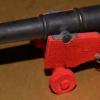

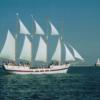



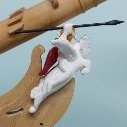
.thumb.jpeg.fc5d633a7b34428fcf19419a73d56d55.jpeg)
